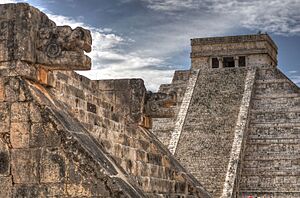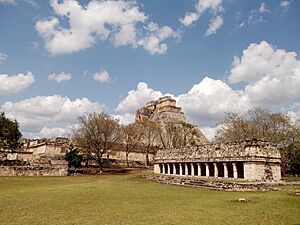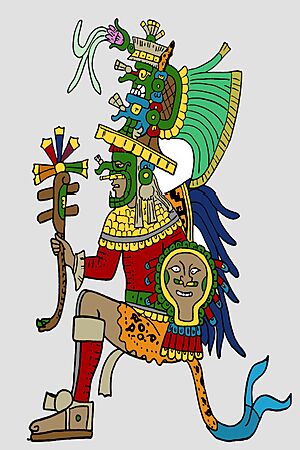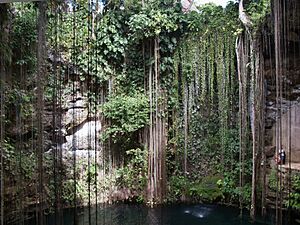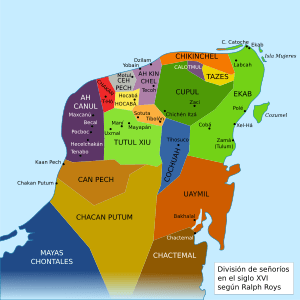League of Mayapan facts for kids
Quick facts for kids
The League of Mayapan
|
|||||||||||||||||||||||||||||
|---|---|---|---|---|---|---|---|---|---|---|---|---|---|---|---|---|---|---|---|---|---|---|---|---|---|---|---|---|---|
| 1007–1441 | |||||||||||||||||||||||||||||
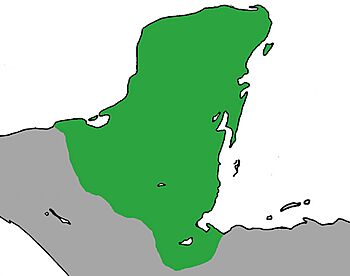
The League of Mayapan at its greatest extent, circa 1200
|
|||||||||||||||||||||||||||||
| Capital | Mayapan, Uxmal, Chichen Itza | ||||||||||||||||||||||||||||
| Common languages | Yucatec, Chontal, Itza, Mopan, Lakantun, Q'eqchi, Ch'orti', Sakapultek, Pokomchi, Sakapultec Uspantek Q'anjob'al | ||||||||||||||||||||||||||||
| Religion | Maya religion | ||||||||||||||||||||||||||||
| Government | Monarchical confederation | ||||||||||||||||||||||||||||
|
• 987–1007
|
Ah Mekat Tutul Xiu (first) | ||||||||||||||||||||||||||||
|
• 1441–1461
|
Ah Xiu Xupan (last) | ||||||||||||||||||||||||||||
| Historical era | Postclassic period | ||||||||||||||||||||||||||||
|
• Ah Mekat Tutul Xiu unites Chichen Itza, Mayapan, and Uxmal
|
1007 | ||||||||||||||||||||||||||||
|
• Hunac Ceel Cauich claims divine power and attempts to reform the government
|
1194 | ||||||||||||||||||||||||||||
|
• Rebellions by the Tutul Xiu and their allies disintegrate the government
|
1441 | ||||||||||||||||||||||||||||
|
|||||||||||||||||||||||||||||
| Today part of | Mexico Guatemala Belize Honduras |
||||||||||||||||||||||||||||
The League of Mayapan (Yucatec: Luub Mayapan Maya glyphs: ![]()
![]()
![]()
![]()
![]()
![]()
![]() ) was a group of Maya states that worked together. It existed in the Postclassic period of Mesoamerica, which is a historical time period. This league was located on the Yucatan peninsula.
) was a group of Maya states that worked together. It existed in the Postclassic period of Mesoamerica, which is a historical time period. This league was located on the Yucatan peninsula.
The main groups in the league were the Itza, the Tutul-Xiu, and the cities of Mayapan and Uxmal. The name "Mayapan" means "flag of the Maya."
Contents
Before the League was Formed
The Itza People
The Itza were sometimes called "water witches." Around the year 325, they began moving to Bacalar from the Peten area. Many of them then traveled northwest. They took over an old Maya city called Uuc Yabnal and renamed it Chichen Itza. They lived there from 550 to 692. Later, for economic and political reasons, the Itza moved to Chakan Putum. They stayed there until 928, when they returned to Chichen Itza.
The Tutul Xiu People
The Tutul-Xiu were known for their "overflowing virtue." In the 7th century, they moved to Yucatan. Their leader, Ah Suytok Tutul Xiu, also known as Chac Uitzil Hun, founded the city of Uxmal. The exact date this happened is debated by different old Maya books. In 869, another ruler, Ah Mekat Tutul Xiu, moved the Tutul Xiu capital to Uxmal from a place called Nonohual. The location of Nonohual is not fully known. It might have been in Peten, or it could have been another name for Potonchán in Tabasco or Tula. The Tutul Xiu were a major group that pushed the Itza people out of Chichen Itza.
The Cocom Family
The Cocom family was known as "the lineage of the wood pigeon." They lived further west and forced the Itza out of Chakan Putum. The Itzas then spent 40 years living in the rainforest. They called this time "Xulucmul," which means "living under the trees in ash and poverty."
How the League Started
Before the League of Mayapan was formed, the Toltec people invaded Yucatan. Their leader was a legendary king named Kukulcan. Whether Kukulcan was a real person or a myth, the Toltecs had a strong influence on the Maya people there.
An old record by Diego de Landa says: "The Indians who lived in Chichen Itza were ruled by a great lord called Kukulcan. They even named their main building Kukulcan. They say he came from the west and that he returned to Mexico to become one of their gods, called Cezalcuati [Quetzalcoatl]."
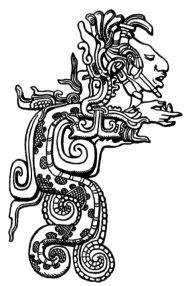
Ah Mekat Tutul Xiu is believed to be the ruler who started The League of Mayapan in 987. He brought together the cities of Chichen Itza, Mayapan, and Uxmal. Chichen Itza was the most important city, with about 50,000 people. He also included other areas like Zama (Tulum), Ichpatun, Itzamal, and the Cocom region into the league.
Hunac Ceel Cauich and Changes
Around 1175, the league began to have problems. A man from the Cocom family named Ceel Cauich Ah was thrown into the cenote of Chichen Itza as part of a ritual. A cenote is a deep, natural sinkhole filled with water. The Sacred Cenote was very important to the Maya. They believed it was a way to the afterlife and a place for pilgrimages. It was 15 meters deep, and its steep walls made it almost impossible to climb out. But Ceel survived and climbed out! He used this as a sign that he had a special right from the gods to rule. He declared himself an Ajaw, which was a spiritual and political leader. He also changed his name to Hunac Ceel Cauich.
However, the Itza people did not believe him and refused to accept his rule. Ceel gathered many followers from Mayapan and the Cocom region. In 1194, Hunac Ceel Cauich started a war against Chac-Xib-Chac, who was one of the four rulers of Chichen Itza.
The Story of Chichen Itzá's Decline
Scientists believe that Chichen Itza began to decline before Mayapan became powerful. However, old stories and legends tell a different tale about why Chichen Itza became less important.
These traditional stories say that Hunac Ceel Cauich had a daughter named Sac Nicté. Her name means "white flower" in the Yucatec Maya language. Sac Nicté fell in love with a royal from Chichen Itza named Canek. His name means "black snake" in Yucatec. They met when Sac Nicté was 15 and Canek was 21. This was the same day Canek became the ruler of the Itza. The Itza chose a new ruler every "Katún Ahau," which was a period of almost 20 years. Canek became ruler on November 22, 1194.
Sac Nicté and Canek fell in love right away. But Sac Nicté was already promised to marry Ah Ulil, the ruler of Izamal. Canek and Sac Nicté spent time together, and Canek was very sad because he knew he could not marry her. The wedding between Ah Ulil and Sac Nicté was planned for December 29, 1194.
Three days before the wedding, the engaged couple arrived in Uxmal. Gifts came from all over the land, including gold, animal tusks, perfumes, emeralds, and turtle shells filled with beautiful quetzal feathers. These gifts came from many cities, but nothing arrived from Chichen Itza. On the wedding day, Uxmal was decorated with ribbons, feathers, plants, and bright bows. People were dancing and celebrating in the streets. Important leaders and nobles arrived with musicians. Canek was invited, and he came with sixty of the Itza's best soldiers.
Canek and his warriors ran to the altar where Sac Nicté was about to be married. Incense was burning, and a priest was chanting. Sac Nicté, Canek, and the sixty warriors quickly left Uxmal. Everything happened so fast that no one could stop them. Hunac Ceel, Ah Ulil, and other leaders gathered a large army and went to Chichen Itza. But they found the city completely empty. The legend says that Sac Nicté led the Itza people to Nojpetén, where they started a new Itza Kingdom.
The End of the League
In 1441, Ah Xiu Xupan, a powerful ruler from Uxmal, was given the task of fighting the royal family of the Cocom. He managed to defeat them. Only one Cocom family member, who was in Honduras at the time, survived. He later founded a place called Tibolón.
The war between Uxmal and the Cocom family caused the League of Mayapan to fall apart. There were disagreements between different areas, and many rebellions started. By 1461, the league had completely broken up.
After the war, Yucatan split into seventeen smaller states called Kuchkabals.


